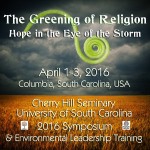This post from my presentation at the recent Greening of Religions conference organized by Cherry Hill Seminary.
(Continued from Part 1)
This raises the question what exactly the word “nature” really means to Pagans.[17] In his study of the rise of Paganism in America, Chas Clifton, the editor of The Pomegranate: The International Journal of Pagan Studies, distinguishes what he calls “Cosmic Nature” from the “Gaian Nature.”[18] The former is a symbolic “nature”, the value of which lies in the esoteric truths it holds for humanity, whereas the latter is an “embodied” nature, which has its own intrinsic value, apart from its usefulness to humans.
The distinction can perhaps be illustrated by contrasting the “nature” of Transcendentalists like Thoreau, who never left the tame woods of the village of Concord[19], and the “nature” of John Muir, whose environmental activism arose directly out of his immersion in the wild nature of the Sierras. Many Pagans’ conception of nature is located more on the Cosmic end of this spectrum, with only a tenuous connection to Gaian Nature. In other words, “nature” for some Pagans may be more of a social construct than a direct experience, a romanticized or idealized “nature” which serves as little more than a backdrop to esoteric rituals.
Chas Clifton has challenged Pagans to “[l]ive so that someone ignorant about Paganism would know from watching your life or visiting your home, that you followed an Earth religion.”[20] Peg Aloi, who studies Paganism in the media, seriously questions whether we Pagans have lived up to that challenge:
“There are now hundreds of thousands of people who identify as ‘pagan’ or ‘Wiccan’ or ‘Druid’ … who have never conducted a ritual out of doors, who have never attended a festival at a campground, who have never planted a garden in honor of the Eternal Return of the Earth Mother in spring. Do [we] discuss the gods and [our[ ritual practices and spells and theology [and go to adadmic conference]? Sure! But do [we] get their hands dirty, in actual dirt?”[21]
And what about Pagan environmental activism? There have been and still are many Pagans who are shining lights of sustainable living and environmental activism. Starhawk and Dragon Environmental Network are just a couple of obvious examples that come to mind. And yet, in some ways the symbolic prominence of these examples may obscure a lack of ecological commitment among Pagans at large. Preliminary reports of Dr. Kimberly Kirner’s as-yet unpublished study of indicate that practices related to nature spirituality and connecting to place are not statistically correlated to sustainable household-level actions:
“Across Pagan traditions and for both solitary and group practitioners, Pagans’ overall household ecological footprint in the United States is statistically similar to the American average on multiple measurements: house size, meat consumption, transportation use, and other key factors related to a household’s contribution to ecological sustainability.”[22]
Kirner did find that Paganism was statistically correlated to a higher frequency of political action, such as signing petitions or writing letters, and environmental education. In spite of this, anecdotal and impressionistic evidence suggests that there is a mismatch between the story we Pagans tell about ourselves and our level of ecological engagement.[23] While many Pagans do participate in direct action, we often do not do so in an organized fashion or at levels one might expect given the unique theological incentive that Pagans enjoy.
A good example of this is the 2014 People’s Climate March in New York. Hundreds of Pagans participated, led by Courtney Webber and others, and their work is to be applauded. And yet a more substantial Pagan presence might be expected in an action that drew hundreds of thousands of people. If we assume there are one million Pagans in the United States, then the proportional representation of Pagans at the Climate March (0.05%) was a fraction of the percentage of Pagans in the population at large (0.3%) — a difference of a factor of six (6).
Jonathan Woolley, who recently reported from the 2015 United Nations Climate Change Conference in Paris, contrasted the presence of other faith traditions to Paganism’s relative absence from the event:
“Christian churches have been very active in recent years in throwing their energies behind the climate movement. … Other spiritual groups have done likewise: even when they lack centralised ecclesiastical institutions (such as Islam), or when they’re small communities that struggle to afford the cost of traveling to these events (as is the case for indigenous communities).
“Pagans, by contrast, have yet to engage in this organised fashion. Though we may be active participants as individuals, our organisations have shown a puzzling lack of initiative; failing to capitalise upon the almost unique relevance of our philosophies to climate change. While it has taken a seed-change in Christian theology, and a harnessing of long-neglected (but nonetheless orthodox) parts of Christian thought to respond to this Great Challenge of our Age, no such shift is necessary within Pagan religions — we share a common, compelling reverence for Nature; either as the body of the goddess, as an utterly animate cosmos, or as the province of many deities. It should be the easiest thing in the world for us to take our place in spaces like COP, and to command great power and respect when we do so: and yet, this has not happened.”[24]
There are several possible reasons for this. Perhaps the most obvious explanation is Paganism’s small numbers and lack of organization or intentional dis-organization. However, as Woolley points out, lack of centralizing institutions has not prevented other faith communities from organizing for direct action, a conspicuous example being indigenous peoples. And in the age of social media, lack of formal institutions is not the barrier to organizing that it used to be.
Other factors include many Pagans’ suspicion of interfaith or their ambivalence toward the “politicization” of religion.
Another possible explanation, one external to Paganism, is that Pagans might be discouraged, implicitly or explicitly from joining environmental actions by secular activists or other faith groups who are concerned that association with Paganism may damage their credibility. Considering how environmentalism is often slurred with the epithet of “pagan” by some political conservatives[25], this concern may not be entirely unfounded. Those who malign environmentalists for their “paganism” are probably already convinced that environmentalism is evil, and the association with “paganism” is a post hoc rationalization. However, it is possible that even more liberal monotheists and secularist, who are sympathetic to earth stewardship, might be put off by an association with contemporary Paganism.
In addition, some professed interfaith environmental groups are only interested in working with the Abrahamic faiths or with those faiths considered “World Religions.”
This suggests Pagans have more work to do, not just in environmental activism, but also in the area of interfaith. Contemporary Pagans owe a profound debt to those like Andras Corban-Arthan and Angie Buchanan of EarthSpirit, Selena Fox and Patrick McCollum of Circle and Lady Liberty League, Don Frew and M. Macha NightMare of the Covenant of the Goddess, the administration and faculty of Cherry Hill Seminary, and many others for their continuing work in this area. Because of their courage and dedication, many no longer see Paganism as something to be feared. However, I am certain all of these individuals would agree that work remains to be done.[26] Paganism is less feared, but many people continue to see Paganism as something to be ridiculed or dismissed.[27]
One way Pagans might increase their credibility in the interfaith community would be for us to find ways to speak with harmonious voices on the critical issues of our day, like climate change. While many Pagans are no strangers to political action, the effectiveness of our actions may sometimes be diminished by the cacophony of our diverse voices. If we could join our voices in protest as well as we can join our bodies and spirits in ritual, then our actions would carry that much more weight. We must appreciate that speaking “in harmony” with each other does not necessitate us all being of one mind or agreeing on every point. We Pagans often speak of attuning ourselves to nature and the cycles of the Earth. Similarly, we need to strive to “attune” with one another, temporarily setting aside our egos and prioritizing our individual disagreements, when a collective voice is urgently needed to effect change, as it is now. If there is any issue on which we Pagans should be able to speak harmoniously, it is in response to the desecration of the environment.
Members of other religions have shown us that this is possible. In 1986, the World Wildlife Fund brought together Buddhist, Christian, Hindu, Jewish and Islamic leaders in the Italian town of Assisi to produce declarations on each religion’s understanding our sacred duty to nature.[28] By 1995, Baha’is, Daoists, Jains, Sikhs, Shintoists and Zoroastrians had joined together with members of the “Big Five” in the Alliance of Religions and Conservation to draft similar statements for each of their respective faiths.[29] Their work is an example of how other religions, with their own manifold internal divisions, can still speak with a collective voice on what is perhaps the most urgent issue of our day. Similar eco-faith statements can be found at GreenFaith.org and Interfaith Power & Light.
Inspired by these statements, as well as Covenant of the Goddess statement on the environment which was published in August 2014[30], and spurred by the increasingly urgent need for a collective response to our environmental crisis, a diverse group of Pagans gathered together to prepare a draft Pagan Community Statement on the Environment. A special effort was made to invite individuals from a variety of different Pagan traditions, with the understanding that no such group could be truly representative of the diversity of the Pagan community. The group of about 40 individuals worked on the statement for six months. In April 2015, a draft of the statement was posted at ecopagan.com for period of public comment. Additional revisions were made by the working group in response to the comments received, including changes to make it more clear that the statement only intended to speak for those who signed it.
The statement was published in its final form on Earth Day, April 22, 2015, and was made available for electronic signatures at ecopagan.com.[31] Thousands of signatures from Pagan individuals and groups quickly poured in from around the world. Signatures have come from over 80 countries. And the statement has been translated into 16 languages. Signatures have been received by a wide variety of Pagans. Numerous Pagan organizations have signed as well, including Cherry Hill Seminary, the Pagan Federation, Covenant of Unitarian Universalist Pagans, Covenant of the Goddess, Circle Sanctuary, Earth Spirit Community, Ár nDríaocht Féin (ADF), Order of Bards, Ovates & Druids (OBOD), Aquarian Tabernacle Church, Feraferia, the Fellowship of Isis, and numerous Pagan Pride organizations.
As should be expected with any such statement, some individual Pagans felt that the statement was too specific, while others thought is was not specific enough. Some felt that it went too far, while others felt that it didn’t go far enough.[32] In spite of this, thousands of signatories felt that the urgency of the message justified harmonizing their voices with other Pagans around the world at this critical time in history. By and large, the statement has been received as it was intended: not as a declaration for all Pagans, but as an invitation to join our voices to those of others raised in defense of all life on Earth … and a call to action.
The title of this conference is “The Greening of Religions.” There is a presumption among many Pagans that Paganism is and always has been a “green” religion. In fact, Oberon Zell has called it “the Green Party at prayer.” But Paganism, like every religion, is a complex mixture of concepts and practices that can be used to either rationalize environmental neglect or encourage ecological harmony. Rather than characterizing Paganism, or any other religion, as “green” or “not green,” we might rather speak about the “greening of religions,” an ongoing, never-to-be-complete process. In this way, we can understand the history of contemporary Paganism as a “greening,” one that is still going on, and A Pagan Community Statement on the Environment, as one small but valuable part of that process, one that I hope will inspire deeds as well as words.
May all of our religion continue their greening.
Notes:
[17] Bowman, Marion. “Nature, the Natural and Pagan Identity,” DISKUS Volume 6 (2000).
[18] Clifton, Chas. Her Hidden Children: The Rise of Wicca And Paganism in America (2006). 
[19] Gould, Rebecca Kneale. “Transcendentalism”; “Thoreau, Henry David (1817-1862)”; “Emerson, Ralph Waldo (1803-1882); and Holmes, Steven J. “Muir, John (1838-1914); Encyclopedia of Religion and Nature, ed. Bron Taylor (2005). 
[20] Clifton, Chas. Witchcraft Today, Book One: The Modern Craft Movement (1997). 
[21] Aloi, Peg. “Has Pagan Environmentalism Failed? Yes, Yes, A Resounding Yes.” (July 25, 2014).
[22] Reported by Beckett, John. “We’re Still Here and the Earth is Still Sacred” (July 22, 2014)
[24] Woolley, Jonathan. “I’ll meet you on the Field of Mars – A Druid’s view of COP21” (Dec. 28, 2015).
[25] Pitzl-Waters, Jason. “Paganism as Slur, Paganism as the Other” (July 2, 2013); Harris, Grove. “Pagan Involvement in the Interfaith Movement: Exclusions, Dualities, and Contributions,” Cross Currents, Vol. 55, No 1 (Spring 2005).
[26] Pitzl-Waters, Jason. “Modern Paganism’s Role in Interfaith” (January 24, 2012)
[27] “Dude, Pagans don’t have an agenda. They’re Pagans. Organizational skills, eh, not their strong suit.” — Comedian Jon Stewart on The Daily Show responding to an open letter by the Bob Jones University president referring to “the agenda of paganism.” 
[29] Alliance of Religions and Conservation website. 
[30] “The Covenant of the Goddess adopts formal position on environmental issues.”
[31] http://ecopagan.com 















